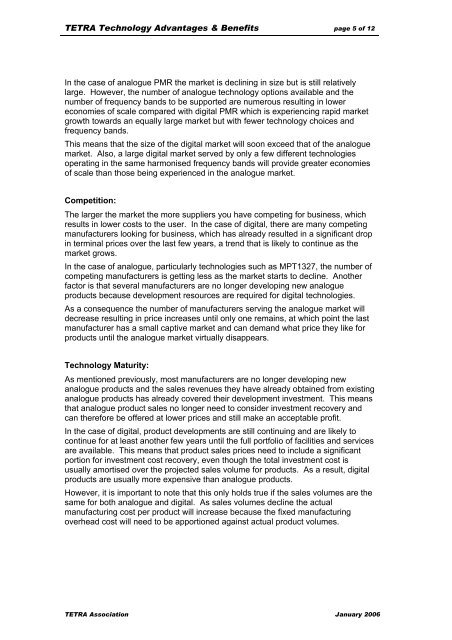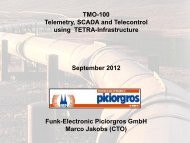TETRA Technology Advantages & Benefits
TETRA Technology Advantages & Benefits
TETRA Technology Advantages & Benefits
You also want an ePaper? Increase the reach of your titles
YUMPU automatically turns print PDFs into web optimized ePapers that Google loves.
<strong>TETRA</strong> <strong>Technology</strong> <strong>Advantages</strong> & <strong>Benefits</strong> page 5 of 12In the case of analogue PMR the market is declining in size but is still relativelylarge. However, the number of analogue technology options available and thenumber of frequency bands to be supported are numerous resulting in lowereconomies of scale compared with digital PMR which is experiencing rapid marketgrowth towards an equally large market but with fewer technology choices andfrequency bands.This means that the size of the digital market will soon exceed that of the analoguemarket. Also, a large digital market served by only a few different technologiesoperating in the same harmonised frequency bands will provide greater economiesof scale than those being experienced in the analogue market.Competition:The larger the market the more suppliers you have competing for business, whichresults in lower costs to the user. In the case of digital, there are many competingmanufacturers looking for business, which has already resulted in a significant dropin terminal prices over the last few years, a trend that is likely to continue as themarket grows.In the case of analogue, particularly technologies such as MPT1327, the number ofcompeting manufacturers is getting less as the market starts to decline. Anotherfactor is that several manufacturers are no longer developing new analogueproducts because development resources are required for digital technologies.As a consequence the number of manufacturers serving the analogue market willdecrease resulting in price increases until only one remains, at which point the lastmanufacturer has a small captive market and can demand what price they like forproducts until the analogue market virtually disappears.<strong>Technology</strong> Maturity:As mentioned previously, most manufacturers are no longer developing newanalogue products and the sales revenues they have already obtained from existinganalogue products has already covered their development investment. This meansthat analogue product sales no longer need to consider investment recovery andcan therefore be offered at lower prices and still make an acceptable profit.In the case of digital, product developments are still continuing and are likely tocontinue for at least another few years until the full portfolio of facilities and servicesare available. This means that product sales prices need to include a significantportion for investment cost recovery, even though the total investment cost isusually amortised over the projected sales volume for products. As a result, digitalproducts are usually more expensive than analogue products.However, it is important to note that this only holds true if the sales volumes are thesame for both analogue and digital. As sales volumes decline the actualmanufacturing cost per product will increase because the fixed manufacturingoverhead cost will need to be apportioned against actual product volumes.<strong>TETRA</strong> Association January 2006
















